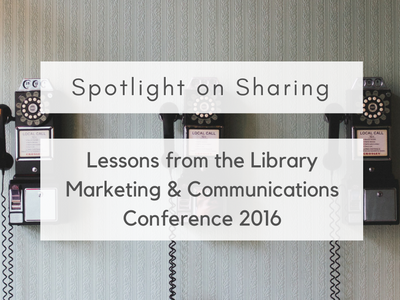 I recently returned from the second annual Library Marketing and Communications Conference (LMCC), which was held in Addison, Texas on November 16 & 17, 2016. The event, put on by Amigos Library Services, brought together library communications professionals of all different backgrounds and levels of expertise, from trained communications specialists to librarians who “accidentally” wound up in the role.
I recently returned from the second annual Library Marketing and Communications Conference (LMCC), which was held in Addison, Texas on November 16 & 17, 2016. The event, put on by Amigos Library Services, brought together library communications professionals of all different backgrounds and levels of expertise, from trained communications specialists to librarians who “accidentally” wound up in the role.
The participants I spoke with agreed that they were clamoring to spend time with other library communications professionals, especially since this is the only conference of its kind. Registration was at capacity, with over 300 attendees coming from all over the U.S. and Canada.
Programs covered a range of communications topics: social media, environmental signs, tools and tips, collaboration opportunities, graphic design, branding, strategy, and more (see the full program). There was something for every type of library communications professional, from the beginner to the highly experienced. View the backchannel conversations on Twitter with the hashtag #LMCC16.
My goal in attending LMCC was to bring back pertinent information for libraries of all sizes, but especially for smaller libraries that don’t often have dedicated marketing and communications staff. Here is what I found the most useful; I hope you will find useful as well.
Start with a Communications Mindset
Every project, no matter how large or small, should include the question, “How will we communicate this?” Including marketing and communications from the beginning can result in a better product in the end since it forces us to consider the project from different angles. The opposite of this holistic approach is the “Can you make me a flyer” syndrome, where marketing is an afterthought to the real planning process.
Pick the Tools that Match Your Users
A diverse communications strategy will help you reach a wider audience, but that doesn’t mean you need to take on every new technology that comes along. Use feedback from your users to find the best ways to reach them, then choose the media channels that make sense. Your community might prefer email newsletters, blogs, and Facebook, while another community might prefer to learn about library events in the local newspaper. Just as with planning your programs and services, you should base your communications strategy on the needs of your community.
Inspire Others to Share Your Story
The most powerful way to use social media is to inspire your followers to be your advocates. When a follower shares your post, they are incorporating your library’s message into their personal online “brand”, so give them content that they want to share with their friends. Here are some best practices for making your content shareable:
- Be a human first. Your followers want to connect with people, not buildings, policies, or faceless entities.
- Post questions that are fun to answer or that start conversations, such as “What’s a book you would love to see made into a movie?” or “Should we paint the wall in the Children’s Area blue or green?” Provide easy ways for your followers to engage with you.
- Social media engagement is much higher for posts that use images, so include them whenever possible. (Canva is just one of many online tools that lets you design high quality images for free.)
- Before posting, ask yourself, “Would I share this with my friends?”
Maximize Your Time
Communications is probably one of many hats that you wear at the library, so make the most of your time by using a tool that helps you plan and track your social media content. One presenter shared Ashley Chasse’s The Super Awesome Social Media Content Calendar, though you can use whatever works for you. Also, consider using a management tool like TweetDeck or HootSuite to manage multiple social media accounts. The important thing is to treat your communications like any other task to be planned and tracked.
Branding isn’t a Bad Word
Branding is the process of creating a consistent, well-designed experience for your patrons. It doesn’t have to make your library feel sterile or corporate—good branding means that you craft every point of contact with your patrons in mind. This could mean (but isn’t limited to) designing a new logo, rethinking your internal and external signage, applying User Experience (UX) principles to your website, or offering customer service training to your staff. Wherever and whenever patrons come into contact with your library, they should know that it is your library because of the consistent look and feel.
Relationships Still Rule
The best communications medium is still…air. Keynote speaker and author John Haydon reminded us of this, and told us that the conversations we have with our patrons are the best marketing tools of all. This is great news for small libraries with strong community connections. After all, who better to spread your library’s message than your friends and neighbors?
This post is part of the Spotlight on Sharing initiative, which aims to increase the visibility of resource sharing in Colorado libraries. Reflecting on and sharing out what you learn at conferences helps our entire profession grow. What have you learned recently at a conference? Share it by emailing Amy Hitchner, ahitchner@coloradovirtuallibrary.org. If you’re on Twitter, tweet @hitchlib or use the hashtag #spotlightonsharing.
- Friday Grab Bag, November 16, 2018 - November 15, 2018
- Friday Grab Bag, November 9, 2018 - November 9, 2018
- Friday Grab Bag, November 2, 2018 - November 2, 2018
